Minor Scales on Guitar
Here’s the fast answer: A minor scale is any scale containing the b3 scale degree. If you’re looking into minor scales for the guitar, you are probably looking for the natural minor scale, sometimes called the Aeolian mode. The natural minor scale has the following intervals:
1 2 b3 4 5 b6 b7
And can be played on guitar using the following 3 note per string scale (example in E minor):
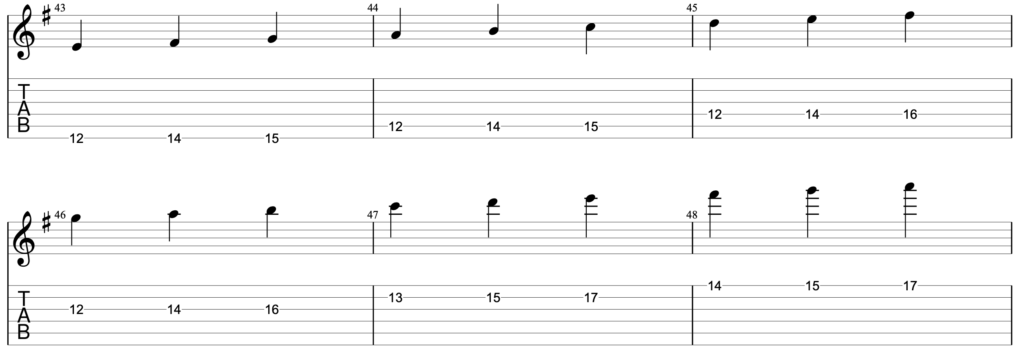 This is the E natural minor scale (Aeolian mode) on guitar.
This is the E natural minor scale (Aeolian mode) on guitar.
Now that we have the simple answer out of the way, let’s dive a little deeper into minor scales, what they are and how we can use them in our guitar playing.
What is The Minor Scale?
As we initially stated, a minor scale is any scale with a b3 scale degree. The minor scale has the following intervals:
1 2 b3 4 5 b6 b7
And if we were to look at this scale in the key of A, creating an A minor scale, we would get the following notes:
A B C D E F G
We’ll look at some examples of this scale on guitar in just a minute, but first let’s talk about minor scales in general.
When looking at minor scales in different keys, it can be useful to compare them using the circle of fifths. In music theory, two keys are considered similar if they contain a similar amount of sharps or flats. The circle of fifths puts the keys in order of similarity.
So, any two keys that are next to each other on the circle of fifths will differ by a single flat / sharp.
If we write out the natural minor scale around the circle of fifths, we can see this clearly:
| Key | 1 | 2 | b3 | 4 | 5 | b6 | b7 | Accidentals | Key Signature |
|---|---|---|---|---|---|---|---|---|---|
| A minor | A | B | C | D | E | F | G | None | |
| E minor | E | F# | G | A | B | C | D | 1 Sharp | |
| B minor | B | C# | D | E | F# | G | A | 2 Sharps | |
| F# minor | F# | G# | A | B | C# | D | E | 3 Sharps | |
| C# minor | C# | D# | E | F# | G# | A | B | 4 Sharps | |
| G# minor | G# | A# | B | C# | D# | E | F# | 5 Sharps | |
| Eb minor | Eb | F | Gb | Ab | Bb | Cb | Db | 6 Flats | |
| Bb minor | Bb | C | Db | Eb | F | Gb | Ab | 5 Flats | |
| F minor | F | G | Ab | Bb | C | Db | Eb | 4 Flats | |
| C minor | C | D | Eb | F | G | Ab | Bb | 3 Flats | |
| G minor | G | A | Bb | C | D | Eb | F | 2 Flats | |
| D minor | D | E | F | G | A | Bb | C | 1 Flat |
Should You Use 3 Note Per String Or CAGED Minor Scales?
When it comes to playing minor scales, or any scale, on guitar, there are several “systems” we can use for organising the notes on the guitar neck. The two main systems that are used are CAGED and 3 Note Per String (sometimes abbreviated to 3NPS).
A full comparison of CAGED and 3NPS is an article for another day, but I prefer to use the 3NPS system because it is:
- Easier to understand.
- Easier to develop speed with.
- Easier to map out on guitar.
- Easier to navigate between scale shapes.
So that is the system that we are going to use in the rest of the article. It’s also the system I advise students to learn - I don’t see any benefit from bothering with the CAGED system for scales.
Natural Minor Scale Examples
How to Play the A Minor Scale on Guitar
If you reference the above table, you can see that the A minor scale contains the following notes:
A B C D E F G
And we can arrange them on the guitar neck, using 3 notes per string, in the following way:
 3 Note Per String A minor scale neck diagram.
3 Note Per String A minor scale neck diagram.
And here is a guitar tab of the above scale:

Note: this is one possible way of many to play an A minor scale on guitar. This is just to get started. A full treatise on all the ways we can play an A minor scale is a lesson for another - make sure you’re subscribed so that you can get updates!
When using the above 3nps minor scale, I recommend you use the following fingers:

How to Play the C Minor Scale on Guitar
If you look at the above table where we had all the notes from all minor scales, you can see that in a scale of C minor, we have the following notes:
C D Eb F G Ab Bb
Here is a neck diagram showing how we can play those notes using a 3NPS scale:
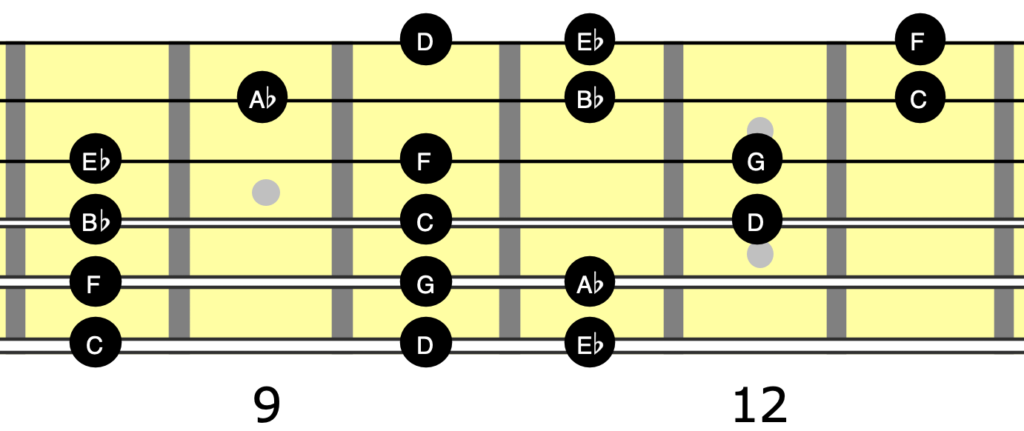
Here is a guitar tab showing which frets to play:

If you look at the A minor scale diagram, you can see that the scale shape for A minor and C minor is exactly the same. All we have done is move the scale horizontally on the neck, to change the note we start from.
So, we can use this pattern to play any natural minor scale that we want.
Just move the pattern up to the correct starting note.
Hopefully from these two examples, you can now play every possible minor scale on guitar.
Where Does the Minor Pentatonic Scale Come From?
The minor pentatonic scale is created by discarding two intervals from the minor scale.
The minor scale has the following intervals:
1 2 b3 4 5 b6 b7
The minor pentatonic scale has the following intervals:
1 b3 4 5 b7
You can see that we create a minor pentatonic scale by discarding the 2 and b6 intervals from the minor scale.
This article has all 5 positions of the minor pentatonic scale on guitar.
What is the Difference Between the Aeolian Mode, the Minor Scale and the Natural Minor Scale?
One of the frustrating things with music, is that every concept has several different names.
The Minor Scale is also known as the Aeolian Mode or the Natural Minor Scale.
These three terms all refer to exactly the same thing.
What Are Relative Major and Minor Scales?
You may have heard the term “relative minor” or “relative major” being used in reference to scales, so let’s quickly take a look at what they mean.
With any major scale, there is a minor scale that has the same notes.
With any minor scale, there is a major scale that has the same notes.
Let’s look at the following two scales:
C major: C D E F G A B
A minor: A B C D E F G
We can see that we have the same notes.
Does this mean that relative major and minor scales are the same?
NO! While these two scales have the same notes, they are note the same scale.
This is because what we hear in western music is not the note that is being played, but the relationship between the notes being played.
When we listen to a C major scale, we hear the note “C” as being the “1” in the scale.
When we listen to an A minor scale, we hear the note “C” as being the “b3” in the scale.
This concept makes more sense when playing over the two chords.
Record yourself playing an Am chord and then a C chord.
Now play a single A note on your guitar over the two chords. Listen to the quality of that note.
You should be able to hear that the note A sounds different over the Am chord, than it does over the C chord.
“Limitations” of the Natural Minor Scale
In music, the “leading tone” is the major 7th scale degree.
This tone is a special type of tone known as a tendency tone. A tendency tone is a tone that wants to move in a particular way.
The leading tone usually wants to move to the root of the scale - especially if it is the highest or lowest pitch that we can hear.
The major scale has the leading tone, but the natural minor scale does not.
In other words, the major scale has a tendency tone that has a very strong draw to the root, but the minor scale does not.
In order to compensate for this, composers in days gone by replaced the b7 in the minor scale with a 7.
Replacing the b7 in the minor scale with the natural 7 gives us a minor scale with the leading tone.
This scale is commonly known as the Harmonic Minor scale.
The Harmonic Minor Scale
If you hadn’t guessed already, when we add the natural 7 to the minor scale, we create what is known as the harmonic minor scale.
This scale is used a lot in neoclassical guitar playing.
The harmonic minor scale has the intervals:
1 2 b3 4 5 b6 7
Here are some examples of this scale:
A Harmonic Minor - Guitar Tablature and Neck Diagram
A Harmonic Minor has the following notes:
A B C D E F G#
So you can see that is very similar to A natural minor that we looked at above. The only note that is different is the 7th, in this case the G, becoming G#.
We can arrange these notes on the guitar as a 6 string, 3 note per string scale as follows:
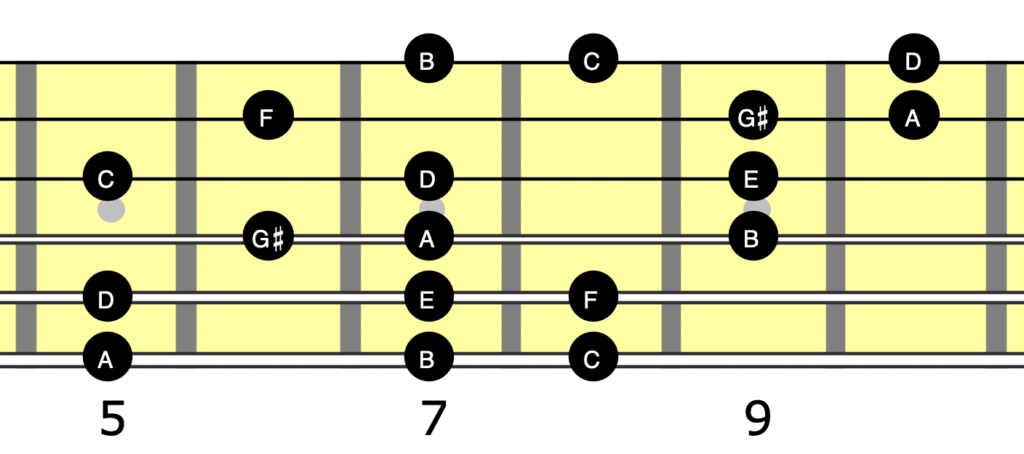

Note that this is the first position of seven.
C Harmonic Minor - Guitar Tablature and Neck Diagram
C Harmonic Minor has the following notes:
C D Eb F G Ab B
We can arrange those notes as a three note per string scale pattern, covering all six strings, as follows:

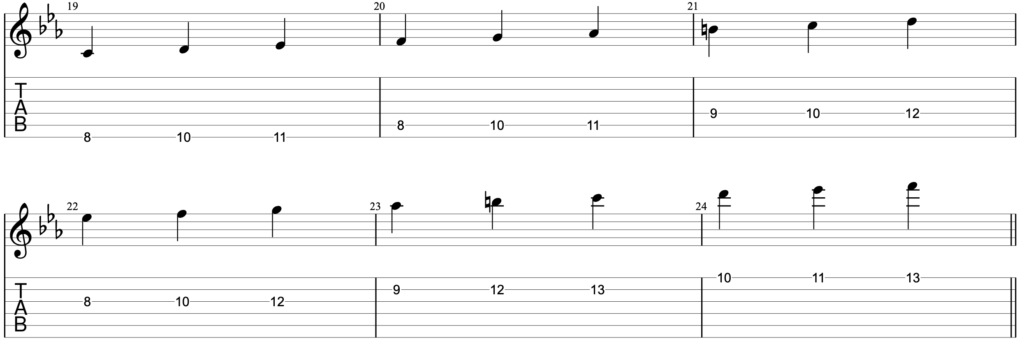
Note that the patterns in the neck diagrams for A and C Harmonic Minor are exactly the same - understanding how to view the guitar in terms of patterns is vital to understanding how to apply these concepts.
Characteristic Sounds of the Harmonic Minor Scale
The distance from the b6 to the 7 is called an “augmented second”, and this interval has two characteristics:
- It has a very distinctive sound.
- It is very difficult to sing.
Point 1 is great because it gives the scale an interesting sound.
Point 2 is not a big deal on an instrument, but is a big deal for singers.
This leads to two approaches that you can take for using the harmonic minor scale in your guitar playing:
- Avoid the aug2nd interval by moving from the b6 to 5, or by moving from the 7 to 1
- Use the aug2nd interval in your melody playing
I generally take the view that it doesn’t matter which option you choose, as long as you do so consciously. Make sure you are adding to your music and not just adding notes for the sake of it.
If you’re writing a part for vocals / choir, then try and avoid using the augmented 2nd interval all together.
What is the Melodic Minor Scale?
As we’ve seen above, the harmonic minor scale gives us some advantages over the natural minor. However, the augmented second interval can be tricky and undesirable in some musical situations (and great in others!).
In order to get around the problems of the augmented second, composers added a major sixth scale degree to the harmonic minor scale.
This created what is called the “Melodic Minor Scale”, which has the following intervals:
1 2 b3 4 5 6 7
As you can see, there is no awkward augmented 2nd interval in the scale.
In fact, we are pretty close to having a major scale here - the only difference is the b3.
This scale is traditionally used only for melodies that are ascending.
However, with the development of jazz, the scale became a scale in it’s own right.
So what I’m saying is, you can use the scale however you want.
If you want a more modern use of the melodic minor scale, use it ascending and descending.
If you want a more common practice or neoclassical sound, then you can use the melodic minor scale when ascending and the natural minor scale when descending.
Here are some examples of the melodic minor scale written out for guitar:
A Melodic Minor - Guitar Tablature and Neck Diagram
A melodic minor has the following notes:
A B C D E F# G#
We can arrange those notes as a 3 note per string scale as follows:
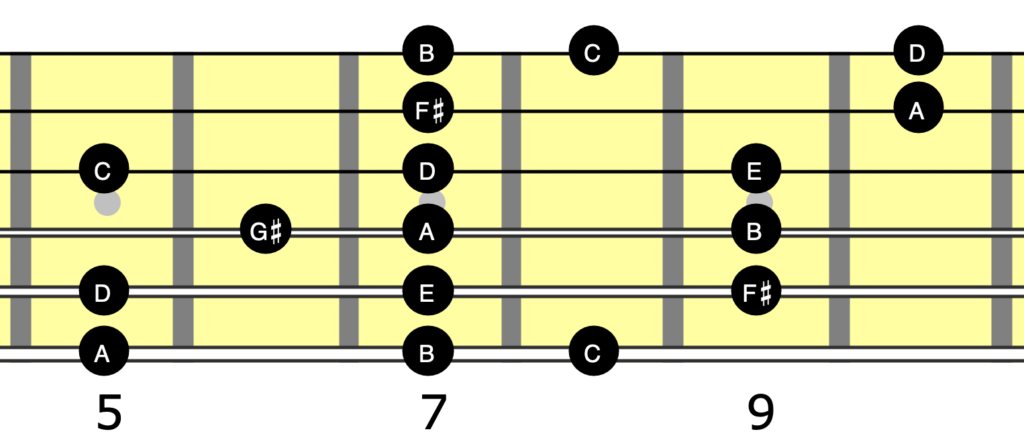

C Melodic Minor Scale - Neck Diagram and Guitar Tablature
C melodic minor has the following notes:
C D Eb F G A B
We can arrange those notes as a three note per string scale covering all six strings on guitar as follows:
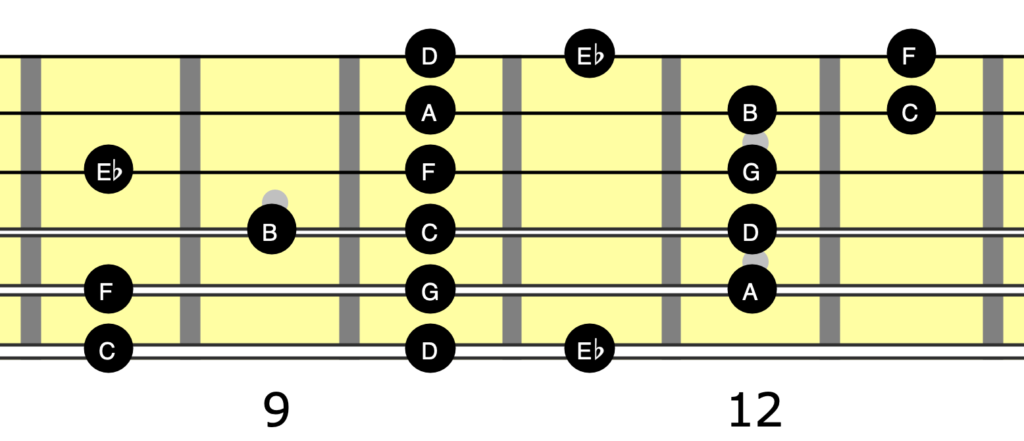
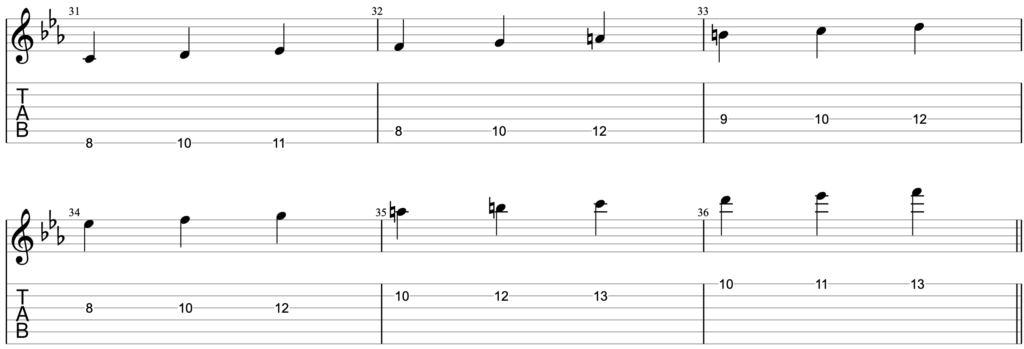
As we noted with the natural minor and harmonic minor scales, observe that the patterns for the two keys are the same. By moving the patterns horizontally, we change the key we are playing it.
The harmonic minor scale is a scale often used in neoclassical guitar playing. The melodic minor is also a great neoclassical guitar scale. It is less used than the harmonic minor, so incorporating it into your playing can be a great way to get an interesting sound.
Which Minor Scale Should You Use?
The natural, harmonic and melodic minor will all “work” over a minor chord.
For example, A natural minor, A harmonic minor and A melodic minor will all fit over an Am chord.
They will all fit, but in different ways, and it’s worth investing some time into practising with the three scales to hear how they work differently over the same chord.
Create some one chord backing tracks for yourself to improvise over and experiment with these scales.
You could also try writing some and modifying them:
- Write some licks in natural minor, then convert them to harmonic and melodic minor.
- Change the key of the licks.
- Change the rhythm of your minor scale licks.
- Experiment with creating some melodic variations on your licks.
A Historical Footnote on the Natural Minor Scale…
As an interesting historical footnote to this article, the aeolian mode has not always been thought of as the “natural” minor scale.
Back in the time of Vivaldi, the dorian mode was thought of as being the natural minor scale.
Having the aeolian mode as the natural minor scale is a relatively modern development in the continuously evolving field of music theory.
Bella Brover-Lubovsky is a member of the faculty of Composition at The Jerusalem Academy of Music and Dance that has written some great papers giving insight into the history of these aspects of music theory. Her papers over at academia.edu are well worth a read.
Intervals in Minor Scales
As a reference, here are the different intervals in the three minor scales that we looked at today:
Natural Minor: 1 2 b3 4 5 b6 b7
Harmonic Minor: 1 2 b3 4 5 b6 7
Melodic Minor: 1 2 b3 4 5 6 7
Conclusion to Minor Scales for Guitar
Hopefully now you have a much better understand of what the minor scale is and how it works on guitar.
While it may be a bit more complex than you initially thought, it is a great set of scales.
Now that you have some material to practice, what should you do with it?
Here are some practice ideas:
- Play these scales in different keys.
- Practice playing the scales over the same chord.
- Try writing some licks in these scales.
- Trying writing some riffs in these scales.
I hope you have a lot of fun exploring these scales. Hopefully you can see that this article is the tip of the iceberg for understanding minor scales on guitar.